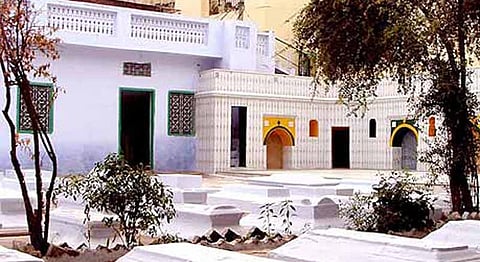
- #HGCREATORS
- #HGEXPLORE
- #HGVOICES
- #HGSHOP
- CAREERS
- ABOUT US
- CONTACT US

Among the seven ancient cities that make up present-day Delhi, Mehrauli has held a strong position in the long history of the national capital. Having hosted kings, sultans, generals, warriors and saints, Mehrauli houses a plethora of monuments, dargahs, tombs and archaeological remains in its winding lanes, each with their own story to tell of the city’s rise, fall, formation and expansion. More than just another congested locality of Delhi, it’s popular for historical gems such as the Qutab Minar, the Jahaz Mahal, Zafar Mahal, Gandhak ki Baoli and the dargah of Qutbuddin Bakhtiyar Kaki to name a few. However, hidden within the Mehrauli maze lie smaller, lesser-known structures that even residents of the area may not know exist. Through the bustling market, past Qutbuddin Kaki’s dargah and partially blocked by shops stands one such structure, with a narrow entrance to a small graveyard, the hijron ka khanqah is a ‘spiritual retreat,’ so to speak, for the hijra community, away from the madness of daily life in the nation’s fast-paced capital.
A small iron gate leads you to an oasis of serenity, despite being a grave of close to 50 eunuchs buried here during the 15th century Lodi era. One stands apart from the white-washed and unmarked headstones, slightly elevated and decorated with tiles is the most important tomb said to belong to a person known as Miyan Saheb. Kanta, a transgender and regular visitor of the khanqah said to Times Of India, “All those who knew more about the history of this place have passed on. For us, the identity of the buried is not important. We know they were like us and fought for our rights’’ The identity of those buried at the site is unknown, though the regions transgender community believes it to be the final resting place of prominent members of the community through the centuries, and considers them sacred, not just for being at the oldest site among other graveyards for transgenders across the city but because of the belief held that those buried here held special powers. Visitors come from all over the city, as well as neighbouring states, to pay their respects at the complex, currently maintained splendidly by transgenders from Turkman Gate and Lal Quan in Old Delhi. “Thousands of people come here to pray because this place is like a shrine, a spiritual retreat. Outside, we are ostracized. People turn away when they see us approaching. Here, we feel at peace,’’ said Komal, another yearly visitor like Kanta.
Eunuchs, or hijras as they’re known across the country, have been said to have a recorded history of over 4,000 years in India. Historical records document their long existence, if not acceptance in society in the past centuries where they were employed as guards by kings to the queen’s quarters, the royal kitchens and the king’s harems. Many even rose to positions of political importance through years of with active roles in the king’s courts, said to be true especially during the Khilji dynasty; the greatest example being Malik Kafur, a eunuch slave who in time became a general in Alauddin Khilji’s army and won him a number of Deccan territories. The situation today is drastically different as most are forced to live on the fringes of society, alienated and discriminated, often resorting to begging and sex work as a means to alleviate poverty due to lack of better employment opportunities. Feared and revered, inspiring both attraction and unwarranted hateful violence, hijras today live ambiguous and prejudiced lives, their presence is seen usually either at traffic signals and auspicious occasions like childbirths and weddings.
Khanqahs were built as spiritual retreats and a place for character building, and this khanqah serves as a surprisingly serene escape which hijras visit usually on major occasions and important festivals, offering prayers, putting flowers on the graves and organising a langar to distribute food and even clothes to fakirs near Qutbuddin Kaki’s dargah. Hijras trace their origins to mythologies of the Ramayana and the Mahabharata and haven’t forgotten the position of esteem they once held. India has slowly changed its stance towards transgenders, we saw the change in the legal position of the community as a ‘third sex,’ which was definitely a major step towards acceptance, but we still have a long way to go when we see the ground-reality of the effects of such changes or lack there off, and in such times, places like the Hijron Ka Khanqah serve as respite from daily discrimination and remembering a time of, what could be called, past glory. “Historically, we were held in very high esteem...we were considered even more beautiful than queens,” said Kanta to TOI. “Today, society fails to recognize us. Will the Supreme Court judgment restore the honour of all those of us who have died in shame, treated as outcasts; will it make people view us any differently?’’
Where: Ward No.6, opposite Mangla Electronics, Mehrauli village. It’s not far from Qutab Minar and the dargah of Qutbuddin Kaki, click here for the location on Google Maps.
When: Open to all from 8 AM to 8 PM
If you enjoyed this article we suggest you read:
Feature image courtesy of The Delhi Walla
